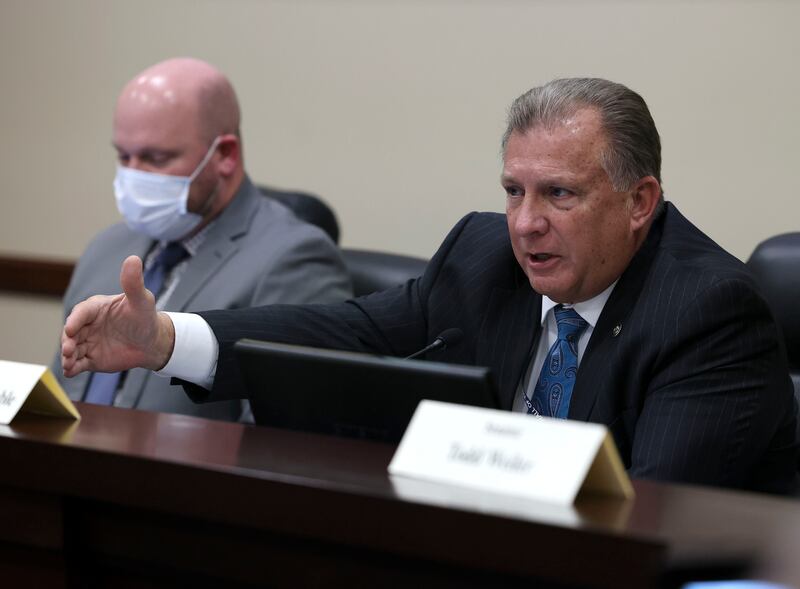I covered a politician years ago who had one glaring weakness, at least in the eyes of his staff. He loved to speak to the media, and he loved to be brutally candid. Someone from a rival party called him “solar mouth” because he would begin talking as soon as the lights of a television camera came on.
Staff members did everything they could to keep me away, but I knew that if his door was open and I could make eye contact, I could get in and ask whatever I wanted, which often was just a clarifying question about a pending issue.
If the door was closed, that was different.
I never knew any journalist who, except in the most extraordinary circumstances, wouldn’t knock or ask permission to enter an elected official’s office. There were unwritten rules about decorum, and those still exist.
Time and again during a state Senate hearing Wednesday over a proposed rule that would place another step between journalists and lawmakers on Utah’s Capitol Hill, senators repeated that they were legislating to the exception, not the rule.
Most media members, they said, were great. The vast majority of interactions between lawmakers and media are civil and respectful, but rules are needed to protect against those (someone put the estimate at 2%) that aren’t.
Other than committee chairman Curtis Bramble, R-Provo, who told of an instance when some media person was trying to talk to committee members in the middle of a hearing, there were few real-world descriptions of these exceptions.
Too bad that person ruined it for the rest of us, and for those who follow the stories and broadcasts of the Legislature.
But the part of SR1 that would restrict media to areas in front of the committee dais except with “permission of the committee chair,” is not the most concerning part of this resolution.
The main part of SR1 concerns how reporters and senators interact on the Senate floor after a day’s session is through. Until now, reporters can be on the Senate floor and grab a senator for a quick interview or, more likely, just a clarifying question about a bill or some other matter. It’s a standard way to make sure the story is accurate and fairly portray the positions of lawmakers.
But SR1 would require reporters to obtain permission from a “Senate media designee” to enter a non-public area to conduct an interview. It sounds like I would need an appointment just to pose a clarifying question.
As with so much that happens on Utah’s Capitol Hill, SR1 is not unique. This separation of lawmakers and reporters is happening across the country.
Writing for the Freedom of the Press Foundation earlier this month, advocacy director Parker Higgins said Iowa and Kansas both have restricted floor access to their state Senates this year. Both states moved media to a public gallery. Utah, he wrote, was following the same script, citing logistical concerns.
Utah’s Senate already has a spot in the gallery for the media. But they have had free access to the floor after a session without any disruption. Lawmakers are, of course, free to decline to answer questions, if they wish.
During Wednesday’s hearing, questions were raised about who qualifies as a journalist. The implication seemed to be that the internet had spawned legions of armchair pundits who now want to grab senators for interviews.
That simply isn’t true. The Utah Legislature has a credentialing process that keeps things from getting out of hand.
Higgins quoted Erin Murphy of the Cedar Rapids, Iowa, Gazette explaining why you should care about this.
“When we work from the press benches on the Senate and House floors, we have direct access to those lawmakers throughout a legislative session,” he told the Committee to Protect Journalists. “All these things that help inform our reporting ... become infinitely more challenging when we’re in the upstairs gallery literally removed from those folks.”
The Utah Senate already puts media in the gallery. Making it harder to conduct interviews only adds to the challenge.
As for those unwritten rules, chairman Bramble asked the journalists testifying against SR1 Wednesday whether they believed it was OK to simply walk into a lawmaker’s office unannounced because, after all, the lawmaker is a public servant working in an office paid for by the public. What if the lawmaker was meeting with a victim of sexual abuse who wanted to remain private?
That kind of intrusion simply isn’t what happens during the normal course of lawmaking in Utah, nor is barging into offices even addressed in SR1.
Government and the media have a necessary, although often uncomfortable, relationship that relies on mutual respect. Both sides benefit. Reporters gain access that allows them to be more accurate. Elected officials can explain their actions, while avoiding the appearance that always seems to accompany the lack of access, which is that they have something to hide.
This issue may yet have a happy ending. Both media members and lawmakers said they were open to the idea of forming a Capitol press corps that would police itself and mediate problems.
But committee members insisted on sending SR1 to the Senate floor, anyway. Legislating to that 2% exception, you know.


